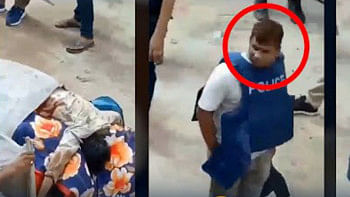Jai Bangla: Visual memoirs of a freedom fighter

Clockwise (from top): “Departure-1”, “Horse-2” and “Jai Bangla” by Shahabuddin Ahmed.
Shahabuddin Ahmed is one of the most recognised painters of our country who carved a niche in the '70s -- a time when a few artists started to experiment, and some painters were busy establishing a personal hallmark. Shahabuddin profoundly established himself as an ardent and devoted painter over the decades. His signature traits are vibrant figures and their poignant movements. The movements are quite dissimilar from those of his contemporaries. Each movement makes what amounts to a distinct look and language. The language is closely connected to the time of the country's turbulent birth and its significant aspects. His paintings encapsulate ecstasy, affections and torment. He wants to visually document a certain time, moments, and he has a great tendency to mingle an era with others.
Shahabuddin's solo painting exhibition, titled “Jai Bangla,” is now on at the Bengal Gallery of Fine Arts, Dhanmondi. All the paintings are oil on canvas.
Shahabuddin is a figurative painter. His approach is semi-realistic. He prefers working on large canvases, according to the requirement of his larger than life themes and styles. Most of his themes are intimately connected with each other.
Shahabuddin's muscular figures clearly refer to a glorious chapter in the country's history. His figures' movements speak the lingo of our freedom fighters and their untold stories. His desires, emotions, hopes and aspirations are strongly allied with the masses of our country. He wants to focus especially on freedom fighters' strengths, their dreams and love for the country.
Shahabuddin roots for the life force and power in the abstract. His images are prominent, determined, and capture forceful motion -- almost in its rawness -- and at times are unmindful of directions.
The artist uses the horse motif in many of his works as a symbol of vigour. The horses appear well built and brawny. The thought process is always connected to the Liberation War and the staunch determination of the guerrillas. His paintings present the Bengalis' reorganisation of themselves and their values.
Shahabuddin's canvas is not quiet or tranquil at all times, sometimes it emerges boldly and projects an audacious look. His works demonstrate contemporary life and times as well. His creations motivate us and stir our patriotic senses.
The artist uses space to gradually interact more with figures. His figures are always the most dominant aspect of his canvas.
Apart from images of the freedom fighters and the Liberation War, Shahabuddin has done some semi-abstract portraits -- extensively of Bangabandhu, but also of Maulana Bhashani, Mahatma Gandhi, Mother Teresa, Rabindranath Tagore and other legendary personalities. The symbolism of the Liberation War blends into the creative homage, which he pays to Bangabandhu. He not only portrays images, but also pours into them human emotions and animated expressions. His skilled hands can capture any kind of struggle, pain and passion.
“Festival” is one of the significant paintings at the exhibition, which clearly denotes the jovial mood of the masses. The image is vast and assembles many episodes of our lives. Red, blue and white have been predominantly used.
“Jai Bangla” is another remarkable work where the artist has focused on a number of freedom fighters heading to an operation. The fighters look very heroic and resolute. Red, yellow and white are dominant colours in the painting.
“Solidarity,” too, is a major work that depicts the desire and longing of the people. Red dominates the image, showing guerrillas advancing. The figures' proximity to each other is also a noticeable feature.
The exhibition continues till October 11.

 For all latest news, follow The Daily Star's Google News channel.
For all latest news, follow The Daily Star's Google News channel. 




Comments